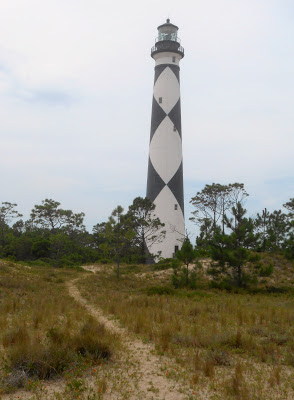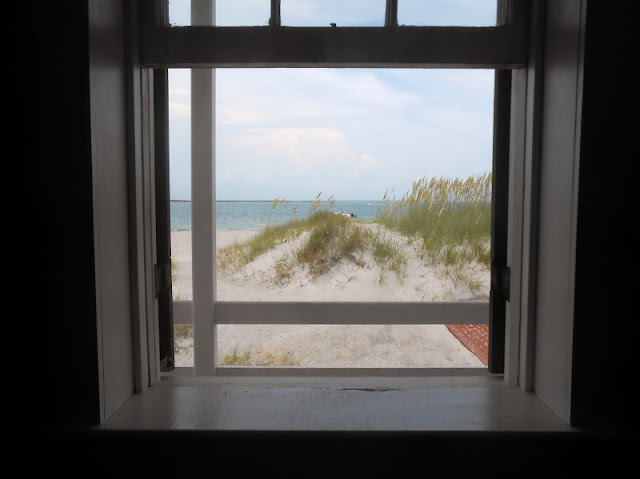Stretching from Ocracoke Inlet to Beaufort Inlet on the North Carolina coast, Cape Lookout National Seashore is the southern-most section of the famed Outer Banks. The Cape, which gives the seashore its name, has been identified on charts dating back to the earliest explorations of the New World. Spanish, English, Dutch, and French explorers, traders, settlers, and pirates all knew and feared the Cape and its shoals. The history of the Cape Lookout region reflects its ties to the sea and its importance in the early sea-borne economy of the nation.
Today Cape Lookout is better known for its outstanding recreational opportunities. Surf fishing, sea kayaking and backcountry camping draw visitors from across the country. For the less adventurous, beachcombing and shelling are favorite pastimes.
The 56 miles of undeveloped beach also provide nesting sites for a wide variety of shorebirds including the endangered piping plovers. Loggerhead sea turtles find the dark deserted beaches ideal for nesting as well.
Cape Lookout Lighthouse
It’s easy to see one of my passions about living in North Carolina is visiting lighthouses. Tracking them down, finding a way to get there is a modern day treasure hunt, at least from the inland. More often than I originally thought, reaching these lighthouses you have to take private and public ferries, cross bridges, drive through residential coastal small towns, and make an adventure out of it. There usually aren’t parking lots or easy access routes to get there. You have to do research and figure out how to actually get there. Some are closed during certain parts of the year, or on specific days, and I’ve gotten lost plenty of times.
 Cape Lookout is located on a barrier island, reachable only by private ferry or the core banks access road, paved by ever shifting sand dunes. Visitors need to pack enough water and food, and camping gear to go to the island, as there are no nearby amenities or conveniences of modern day living. In this sense, visiting Cape Lookout is rustic and you feel like you are camping, which many often do here.
Cape Lookout is located on a barrier island, reachable only by private ferry or the core banks access road, paved by ever shifting sand dunes. Visitors need to pack enough water and food, and camping gear to go to the island, as there are no nearby amenities or conveniences of modern day living. In this sense, visiting Cape Lookout is rustic and you feel like you are camping, which many often do here.
Of all the places I have been in the past year and a half, this is one of my favorite in all of North Carolina. Cape Lookout has this mystery, and this feeling of survival and romance. Many hurricanes have weathered this area, and it is a small miracle in itself the lighthouse is still standing. One day last July, Michael and I decided to go for a getaway weekend.
Just a half hour boat ride, three miles off shore, the Cape Lookout Lighthouse is dressed in black and white diamonds, affectionately known by locals as the Diamond Lady. The white diamonds face the East and West, and the black toward the North and South. On this day, the lighthouse was closed for climbing, but it is only 207 steps to the top and once up there, the climber is rewarded by 360 degree views of the Core Banks. One of the volunteers we met said he had wanted this job his entire life and he looked forward to retiring to volunteer here. He shared with us a beautiful life goal, how he and his grandson want to climb every lighthouse in North Carolina together. I loved his ambition, and I love that other people love the lighthouses as much as I do.
On the ferry toward Cape Lookout, we were lucky enough to glimpse the banker ponies on Shackleford Banks, grazing the marshgrass near the waters edge. The wild horses of the Outer Banks are descendents of spanish horses brought over by Spanish explorers shipwrecked in the 16th century. In the middle of a humid summer, the sweet smell of salty ocean air was a welcome comfort and we took the afternoon to enjoy the beach.
Cape Lookout Trivia
- Cape Lookout National Seashore was authorized in 1966 but was not fully established until 1976 when the state of North Carolina officially transferred the property to the National Park Service.
- The seashore contains 56 miles of undeveloped beaches on four barrier islands. The number of islands within the seashore varies with how many inlets are open or closed following storms.
- The islands of Cape Lookout National Seashore are located between two and three miles off the mainland shore.
- The only part of the park reachable by road is the Visitor Center on Harkers Island. A boat trip – either on your personal boat or one of the commercially operated ferries – is necessary to reach any other part of the seashore.
- Cape Lookout National Seashore is one of the few places on the East Coast where you can experience the magnificence of a dark night sky. The stars appear to shine brighter and seem a little closer when the only artificial light source of any consequence is the periodic sweep of the lighthouse beam.
- There are no hard surface roads on the islands. Any vehicle ferried to the barrier islands must be able to handle the deep sand of the open beach. “Beach driving” at Cape Lookout National Seashore is to be taken literally.

Cape Lookout Attractions
- Beginning Memorial Day weekend and continuing through Labor Day, a variety of ranger-led programs are offered daily. These programs include talks on lighthouse history, surf fishing demonstrations, horse-watching hikes and guided walks through historic Portsmouth village.
- On Shackleford Banks graze a herd of Banker Horses. These small horses freely roam the nine-mile island as their ancestors have done for centuries. The stuff of legends, their very existence sparks the imagination with stories of storms and shipwrecks.
- Just south of Ocracoke Inlet is the Portsmouth Village Historic District. Walking the sandy lanes through Portsmouth transports you back in time to an Outer Banks village of the 1930’s. Here it is easy to understand what it was like to live by the rhythms of the tides, weather and seasons.
